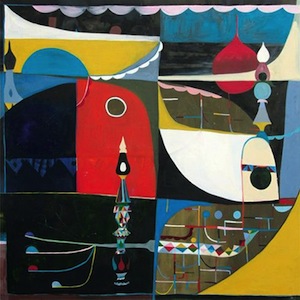Lawrence Films & Windows
We know Lawrence by now. Peter Kersten spent the first decade of the aughts making […]

We know Lawrence by now. Peter Kersten spent the first decade of the aughts making sure of that, releasing four albums with track titles and vibes like he was Hamburg’s minimalistic house Morrissey. Despite an audible reverence for early Chicago house, his own music has always been a bit too florid to scan as purely functional dance music. Even though he uses familiar structures, he always arrives at an emotional ambiguity that makes his music, and the music he releases on his Dial label, an instantly recognizable world of its own. It’s a world characterized by grand statements that falter in the speaker’s mouth—so much is trying to get out, yet only a dribble gets by. But what a dribble! Endless fallow, frostbitten fields as seen from a train window, dotted with horses and poplars whose indifference only makes that inexpressible sadness worse. Such is Kersten’s charm, one that persists on his latest album, Films & Windows, in a substantially different form.
Sonically, Films & Windows is surprisingly bright-eyed. The tracks still proceed at a stately pace, the feelings loosely but suggestively sketched so the listener can fill in the gaps. But it’s surprising how effectively the presence of rubbery synths and neatly clipped drums drive away the fog. The producer’s end game was less clear on his 2011 Pampa 12″, “Kurama” b/w “Oolong High,” which boasted the same hygenic approach to production we find here, but felt endless at points. Things are deliciously slow on Films & Windows, reassuring us that even if our concentration slips, the music will never get too far ahead. The album format also gives Lawrence room to stretch out and be richly emotive, albeit in a spruced-up, cosmopolitan way—we’re looking out through French windows in a well-appointed European flat on this album rather than the grimy commuter-train Plexiglas we were expecting. “Lucifer” sports Lawrence’s signature slouch, but its bubbling sine waves and jaunty riff are fairly kaleidoscopic, making the reference to the god of light feel nicely earned.
The other development here is the presence of high-pitched, harmonic synth pads. They keep the chesty bass bumps on “Angels at Night” in check, cutting through the mix like Mr. Fingers at his most abstract. The pleasure of these tracks is similar to the squeaky-balloon appeal of Ricardo Villalobos; the things it allows you to take for granted make room for a lot of sounds that would come off as willfully weird in another producer’s hands. This has been Kersten’s appeal all along—an overall drift that lets you admire the exotic scenery. He’s trying on a more figurative hat here—the album lacks the Steve Reich marimba patter that bubbled up on Until Then, Goodbye—and we end up as grateful for his new pieces of analog hardware as Lawrence audibly is himself.

